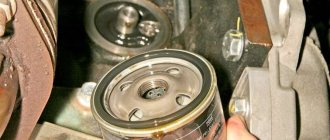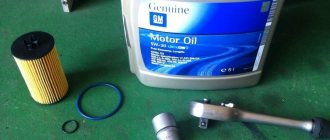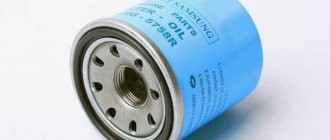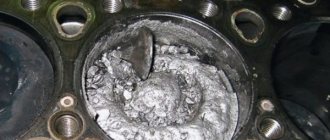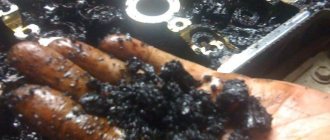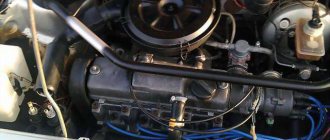The plant's recommendation states that the oil change interval for the Lada Largus engine is no more than 15,000 km. It is this recommendation that should be followed during operation. But under the conditions of everyday city use, where you often have to stand in traffic jams, and accordingly the engine will work out more engine hours, it is necessary to change the engine oil a little more often, at least once every 10,000 km.
You can perform this procedure yourself, and the main thing is to have all the tools necessary for this repair on hand. Namely, we will need:
- Heavy-duty screwdriver or oil filter puller
- Hammer (if there is no puller)
- 10 mm wrench
- Special tetrahedron for unscrewing the drain plug
Regulations for changing engine oil in Lada Largus
Engine oil has its own shelf life and performance properties. It is believed that motor oil should remain inside the engine for no more than 1 year. After this, it becomes unsuitable for further use.
Another factor influencing the condition of the lubricant is mileage. After 15,000 km. the oil picks up a large amount of dirt and deposits, and the additive package will lose its properties and begin to harm the engine.
Thus, the maintenance schedule for Lada Largus is once every 15,000 km. mileage or once a year.
In fact, technical fluid should be replaced more often than once every 10 thousand kilometers. If there is constantly fresh oil in the crankcase, the engine life will increase. In addition, performing this procedure frequently will reduce the likelihood of carbon deposits forming on the pistons and, as a result, will eliminate increased oil consumption in the future.
Criterias of choice
When choosing transmission fluid, pay attention to the specification and viscosity. The API classification is a generally accepted classification that, through testing, determines the effectiveness of extreme pressure and anti-corrosion additives
Elf Tranself NFJ 75W-80 corresponds to the GL-4+ class, which is recommended for use in synchronized manual transmissions of passenger cars. However, it is permissible to use GL-4 and the highest class - GL-5, which is designed for loaded hypoid gears.
This is interesting: DIY materials for repairing car ceiling trim
The SAE marking shows low-temperature (number with index W) and high-temperature characteristics. 75W formulations are recommended for regions where the temperature does not drop below -40°C. If the car is operated at temperatures not lower than -26°C, oils with an index of 80W are poured into the manual transmission. As for high-temperature characteristics, in regions with a temperate climate, a viscosity grade of 85-90 can be used.
For Renault Logan, Sandero, Logan 2, Sandero 2, Lada Largus, you can safely use oils with SAE indexes: 75W-80, 75W-90, 75W-85 and an API specification of at least GL-4.
What kind of oil and in what volume is poured into the Largus engine
It should be noted that this car uses five engines:
- 8 valve - VAZ-11182;
- 8 valve – VAZ-11189;
- 8 valve – K7M;
- 16 valve – K4M;
- 16 valve – VAZ-21129.
Each engine has its own crankcase volume. In this case, the manufacturer pours the same oils into all engines of the same manufacturer. In this case, arguing about which oil is better for Largus is pointless. However, there are several good options:
| Engine | Number of valves | Crankcase volume | Oil |
| VAZ-11182 | 8 | 3,5 | ROSNEFT Premium, ROSNEFT Maximum 5W-40, Lukoil Genesis RN 5W-40 |
| VAZ-11189 | 8 | 3,5 | ROSNEFT Premium, ROSNEFT Maximum 5W-40, Lukoil Genesis RN 5W-40 |
| VAZ-21129 | 16 | 4,4 | ROSNEFT Premium, ROSNEFT Maximum 5W-40, Lukoil Genesis RN 5W-40 |
| K7M | 8 | 4,8 | Elf Solaris RNX 5W-30, Castrol |
| K4M | 16 | 3,3 | Elf Solaris RNX 5W-30, Castrol |
According to the passport, the volume of the VAZ 21129 crankcase is 3.5 liters. But paired with a box from Renault, its volume increases, as an empty cavity appears as a result of using the adapter plate.
The table shows the brands of motor oils that the manufacturer pours into its engines within the walls of the enterprise. These same liquids are used when visiting a dealership. However, it is not prohibited to pour the following brands of oils:
- Shell Helix Ultra 5W40;
- Mobil;
- MANNOL ENERGY JP 5W-30;
- Shell Helix HX-8;
Domestic engines are less sensitive to fluid quality, unlike their counterparts from France. Therefore, they are able to digest even low-grade domestic oils and are not afraid of counterfeits.
In addition to the engine oil, you must select the appropriate filter. The articles are as follows:
| VAZ engines | 21080-1012005-00; 21080-1012005-08; 21080-1012005-09. |
| Renault engines | 7700274177 |
After this, you can start changing the lubricant in the engine.
How to choose the right lubrication system filter?
It's no secret that the main purpose of an engine oil system filter is to clean the fluid circulating inside the unit from impurities that appear over time. Particles gradually form in the oil, which are products of the “life activity” of the motor, which can cause a lot of trouble for the unit itself. As is known, they can provoke increased wear of most of the components present in the design of the cylinder-piston group. This circumstance in most cases leads to a major overhaul of the unit.
Renault Duster configurations and prices 2017
The structural nature of the oil filter for the most part implies the presence of a metal housing, the internal cavity of which is filled by the filter component itself. The oil filter is mounted on a corresponding block element with two valves: a bypass valve and one that prevents fluid drainage. The last of the designated valves prevents the outflow of fluid into the crankcase cavity and is installed in the inlet channel. It closes immediately when the engine stops.
The bypass valve begins to “work” if the system filter fails to perform its function or if the motor “deals” with high-viscosity lubricant.
In any case, the choice of filter should be based on the manufacturer's recommendations.
Step-by-step instructions for changing the oil in Lada Largus
This event is divided into several main stages:
- Drain old oil.
- Replacing the filter element.
- Filling with new engine oil.
Each stage has its own nuances, so they need to be considered separately.
How to drain old oil on Largus
To do this, you need to install the machine on an inspection hole, overpass or lift. The engine must be warmed up. Remove the engine protection, and place a container of at least 5 liters with a wide filler hole under the pan. Unscrew the drain plug:
Lada and Renault engine plugs may vary, but their location is always at the bottom of the engine.
To make the oil drain faster, unscrew the filler cap. This will make it easier for air to enter the crankcase. As soon as the old fluid begins to drip occasionally (after about 10 minutes), the filler plug can be screwed into place. Before doing this, install a new sealing washer if we are talking about a Renault engine.
Replacing the oil filter on Largus
For VAZ and Renault engines, the filter is located on the side of the cylinder block. Naturally, it has differences, but dismantling it is no different.
It must be turned counterclockwise until it comes off. At this point, a small amount of oil may leak from it. A special tool is used to remove the oil filter.
When dismantling the filter element on the K4M and K7M engines, it is necessary to disconnect the negative terminal of the battery or cover the generator with a large rag. The fact is that the distance from the filter to the positive wire of the generator is minimal and there is a risk of causing a short circuit that will harm electrical equipment.
The filter must be twisted and unscrewed with force, but with bare hands. If it does not give way even with the help of a special tool, you need to break it with a long screwdriver and tear it off using the resulting lever.
To install a new oil filter, lubricate its rubber seal with a small portion of new oil and tighten it, observing a tightening torque of 12 Nm.
Pouring new oil into the engine
There is nothing complicated in this procedure. Use the following procedure:
- Make sure the drain plug is tight and the oil filter is replaced.
- Place a funnel in the filler hole and pour the required amount of oil into the engine.
- Start the car engine. Make sure the oil pressure light goes out within 5 seconds. Stop the engine.
- After 3-4 minutes, check the oil level. If it does not meet the standard, drain the excess, pump it out, or vice versa - add the required amount.
- Make sure the level is correct.
2163-13-05a-02
To prevent oil leakage from the crankcase pan, a thin layer of oil-resistant rubber is vulcanized along the surface of the washer hole.
To prevent oil leakage from the crankcase pan, a thin layer of oil-resistant rubber is vulcanized along the surface of the washer hole. To prevent oil leakage from the crankcase pan, a thin layer of oil-resistant rubber is vulcanized along the surface of the washer hole.
Let's examine the puck. If the rubber seal of the washer is damaged, replace the washer with a new one. Drain the oil for at least 10 minutes. We wrap and tighten the drain plug. We remove oil leaks from the engine oil pan and the power unit protection. When changing the oil, the oil filter must be replaced.
Place a container under the oil filter. Unscrew (counterclockwise) the oil filter. If this cannot be done manually...
Why can the oil level in a Largus engine change?
Sooner or later, every car owner may face the problem of decreasing engine oil level. There are several reasons for this phenomenon:
- natural oil consumption;
- reducing its quantity due to leaks.
In the first case, the problem may appear after 150 thousand kilometers on Lada engines. As the piston rings and valve stem seals wear out, lubricant enters the cylinders and begins to burn along with the fuel. In this case, appropriate engine repairs with replacement of faulty elements will help.
Leaks appear due to wear of the oil seals of the moving parts - typical for all four engines. But VAZ engines are also characterized by gasket leaks, which are absent in Renault.

